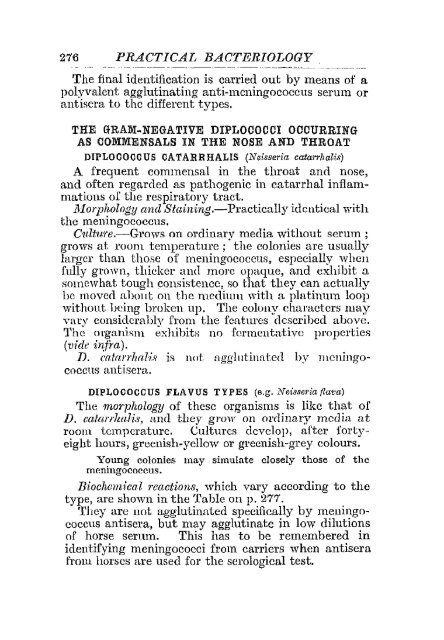AGf~ICULTURAL RESEARCH, PUSA.
AGf~ICULTURAL RESEARCH, PUSA.
AGf~ICULTURAL RESEARCH, PUSA.
You also want an ePaper? Increase the reach of your titles
YUMPU automatically turns print PDFs into web optimized ePapers that Google loves.
276 PRACTICAL BACTERIOLOGY<br />
The final identification is carried out by means of a<br />
polyvalent agglutinating anti-m.eningococcus serum or<br />
antisera to the differcnt types.<br />
THE GRAM-NEGATIVE DIPLOCOCCI OCCURRING<br />
AS COMMENSALS IN THE NOSE AND THROAT<br />
DIPLOCOCCUS CATARRHALIS (Neisseria cata1'1'halis)<br />
A frequent commensal in the throat and nose,<br />
and often regarded as pathogenic in catarrhal inflammations<br />
of the respiratory tract .<br />
.l.1101phology and Staining.-Practically identical ·with<br />
the meningococcus.<br />
C1Iltut·e.-Grows on ordinarv media without serum;<br />
grows at room temperature; . the colonies are usually<br />
larger than those of meningococcus, especially whcn<br />
fully grown, thicker and more opaque, and exhibit a<br />
somewhat tough consistence, so that they can actually<br />
hc moved ahout on the medium with a platinum loop<br />
without lJcing broken up. 'The colollY charactcrs may<br />
vary considerably from the features described above.<br />
The organism exhibitH no fermentative properties<br />
(vide infra).<br />
D. caial'i'lwHs is not agglutinated by mcningococcus<br />
antisera.<br />
DIPLOCOCCUS FLAVUS TYPES (e.g. Neisseria (lava)<br />
The mm'phology of thesc organisms is like that of<br />
D. {:atarrlwlis, and they grow on ordinary media at<br />
rOOlll temperature. Cultures develop, after fortyeight<br />
hours, greenish-yellow or greenish-grey colours.<br />
Young colonies may simulate closely those of thc<br />
meningococcus.<br />
Biochem-tcal -react'ions, which vary according to the<br />
type, are shown in the Table on p. 277.<br />
'They arc llot agglutinated specifically by meningococcus<br />
antisera, but may agglutinate in low dilutions<br />
of horse serum. This has to be remembered in<br />
identifying meningococci from carriers when antisera<br />
from horses a.re used for the serological test.

















